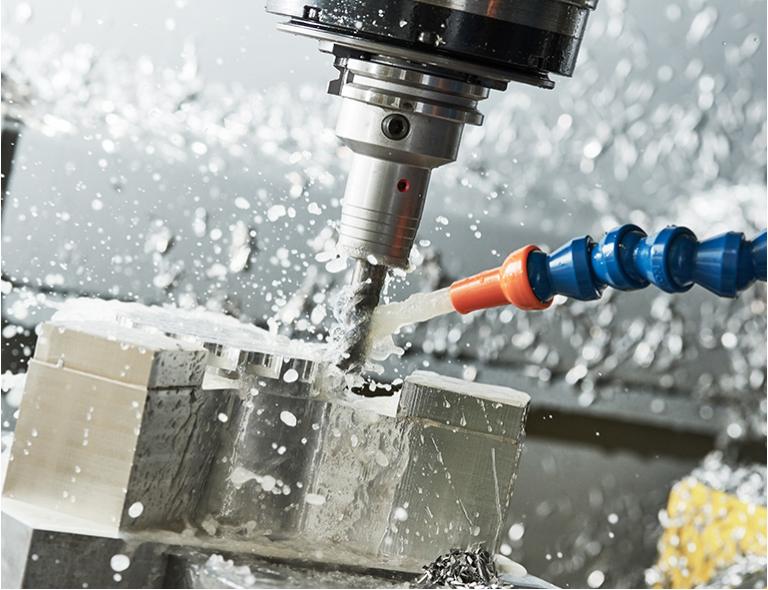
26/08/2025
In the precision mechanics industry, the choice of coolant is a fundamental technical decision, directly impacting crucial aspects of production, including surface finish quality, tool life, machine tool efficiency, system maintenance, and overall operating costs.
The two most common options in manufacturing are neat oil and emulsion (i.e., oil emulsifiable in water). Each of these solutions has specific technical characteristics, application advantages, and operational limitations. Therefore, the choice depends on the type of machining operation, the materials involved, the cutting speed, and the required level of precision.
A quality-conscious mechanical turning shop selects the most suitable coolant after a thorough analysis of production needs. The primary objective is to ensure efficiency, reliability, and long-term durability.
Now, we will explore the advantages and disadvantages of using neat oil or emulsion in precision machining.
Advantages of Neat Oil
Disadvantages of Cutting Oil
Advantages of Emulsion Over Neat Oil
Disadvantages of Emulsions
Having the skills to evaluate when to use neat oil and when emulsion is preferable is a hallmark of professionalism. It means knowing how to interpret machining requirements, understanding material behavior, predicting the impact of thermal variables, and consistently maintaining a high level of quality, efficiency, and safety.
A conscious use of cutting fluids helps reduce waste, preserve tools, keep systems in optimal condition, and deliver a finished product to the customer that meets required standards.
Neat Oil vs. Emulsion: Advantages and Disadvantages in Precision Mechanics
In the precision mechanics industry, the choice of coolant is a fundamental technical decision, directly impacting crucial aspects of production, including surface finish quality, tool life, machine tool efficiency, system maintenance, and overall operating costs.
The two most common options in manufacturing are neat oil and emulsion (i.e., oil emulsifiable in water). Each of these solutions has specific technical characteristics, application advantages, and operational limitations. Therefore, the choice depends on the type of machining operation, the materials involved, the cutting speed, and the required level of precision.
A quality-conscious mechanical turning shop selects the most suitable coolant after a thorough analysis of production needs. The primary objective is to ensure efficiency, reliability, and long-term durability.
Now, we will explore the advantages and disadvantages of using neat oil or emulsion in precision machining.
- Neat Oil
- Emulsion (Water-Emulsifiable Oil)
- Coolant in precision machining: expertise in selection, quality in performance
Neat Oil
Neat oil is a completely oil-based, water-free cooling lubricant used primarily in processes where lubrication is crucial. It is often preferred in processes requiring high precision and high protection of tools and machined surfaces.Advantages of Neat Oil
- High lubricating power: minimizes friction between the tool and the workpiece, ensuring smooth, precise machining with a better finish.
- Equipment protection: the absence of water eliminates the risk of internal corrosion in machine tools, extending their service life.
- Chemical and thermal stability: maintains its properties even at high temperatures, reducing oxidation and degradation.
- Low maintenance: does not require corrective additives or biocides, and does not require frequent replacements.
- Reusability: can be filtered and reused multiple times, reducing long-term costs and waste.
Disadvantages of Cutting Oil
- Higher initial cost: the initial investment is higher than with emulsions.
- Limited cooling capacity: less effective at dissipating heat, it may be less suitable for high-speed machining or machining operations subjected to very high thermal stresses.
- Formation of mist and fumes: can negatively impact the health of the work environment if not managed with adequate extraction systems.
- Carryover: tends to remain on chips and machined parts, generating waste unless an effective recovery system is adopted.
- Susceptibility to contamination: must be protected from water infiltration and kept clean with an efficient filtration system.
Emulsion (Water-Emulsifiable Oil)
Emulsion, composed of a mixture of oil and water, is widely used in production environments where processing temperatures are high and rapid heat dispersion is essential. It is a versatile, economical solution suitable for a wide range of applications.Advantages of Emulsion Over Neat Oil
- Excellent cooling capacity: protects tools and workpieces from thermal deformation, ensuring precision even at high speeds.
- Low refill costs: initially more economical than neat oil.
- Healthier work environment: generates less fumes and mists, contributing to a cleaner and safer production area.
- Versatility: suitable for numerous mechanical processes, from the simplest to the most complex.
- Less drag: facilitates cleaning of the workpiece, reducing overall product consumption.
Disadvantages of Emulsions
- More demanding maintenance: requires constant monitoring of concentration, biocide dosing, and periodic analysis of chemical and physical parameters.
- Corrosion risk: The presence of water, if not managed properly, can lead to corrosion.
- Limited shelf life: The emulsion must be replaced regularly, generally at least once a year.
- Impact on the operator: It can cause skin irritation and unpleasant odors if proper hygiene practices are not followed.
- System compatibility: Some machine tools may require modifications to use emulsions efficiently.
Coolant in precision machining: expertise in selection, quality in performance
In precision mechanical turning, the choice of cooling lubricant is a strategic decision that impacts production performance, the quality of machined components, and the economic sustainability of the process.Having the skills to evaluate when to use neat oil and when emulsion is preferable is a hallmark of professionalism. It means knowing how to interpret machining requirements, understanding material behavior, predicting the impact of thermal variables, and consistently maintaining a high level of quality, efficiency, and safety.
A conscious use of cutting fluids helps reduce waste, preserve tools, keep systems in optimal condition, and deliver a finished product to the customer that meets required standards.

 Design by
Design by